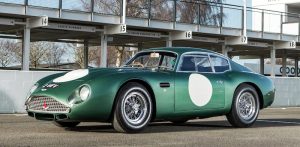FUNKY CHICKENS, PRICELESS ASTONS AND A STABLE THAT WASN’T A STABLE – THE STORY OF JOHN OGIER
STEVE HOLE tells the story of JOHN OGIER
[standfirst] Sir John Lionel Eardley Ogier goes under the radar these days but deserves recognition for his contribution to British motorsport and the automotive industry in general. One thing is certain, despite his importance information is hard to come by, but Sir John Ogier sure was a fascinating man, with an amazing story. We are indebted to Ogier’s son, James for his invaluable help with this feature.
Ogier was born in India on October 23, 1920 (an interesting fact is that his brother, Michael was born on the same day in 1921), but was educated at St Edward’s School, Oxford.
He served an apprenticeship at Austin where he worked with the race team, which is where James Ogier thinks that his father’s love of motorsport was ignited. While at Austin he was also a respected member of the company’s rugby union team.
John joined the Army in 1938 when it became obvious that war with Germany was imminent and was posted to the Queen’s Own Hussars, a regiment with Sir Winston Churchill as honorary Colonel-in-Chief.
He was evacuated from Dunkirk but served with distinction throughout the rest of the war, rising to the rank of Major serving as a tank section commander. He fought gallantly in North Africa at El Alamein … and he won the Military Cross for gallantry during fierce fighting in Italy. It’s said that he rescued his commanding officer while under fire despite being badly wounded. He was further mentioned several times in dispatches. Clearly a very brave man.
When he recovered from his injuries, he was appointed personal assistant to Sir Winston Churchill, whom he clearly impressed as, when hostilities were over, he offered him the job of running his Chartwell estate in Kent for £300 a year (about £8500 today), for just two days work per week, although Ogier refused as he was an ambitious man and had business plans of his own. James Ogier has that original job offer letter from Sir Winston. How cool is that?
Ogier settled in East Hanningfield, Essex (Rough Hill Farm, to be exact) where he became a poultry farmer, having received a lot of information and encouragement from an American called Richard Nixon (no, not that one!). John started his business with a £15,000 loan from his father in 1946 (a massive amount of money back then and equivalent to about £315,755, today!). The term chicken farmer doesn’t really convey the scale of his operation.
He was one of the first to grasp the American ‘broiler’ chicken farming method which followed the ‘intensive farming’ method. Sure, it’s frowned upon these days but back in the fifties, it enabled the man in the street to eat chicken when he wanted (rather than for special occasions), which until then was considered a luxury item. So successful was Ogier’s business that he paid his father back his money within two years!
He later became a director of Buxted Chickens, founded in 1957 in the village of the same name in East Sussex by ex-Battle of Britain pilot, Antony Fisher. Ogier was a partner in the business with Fisher and a Yorkshireman called Guy Reed. For many years Buxted was a very well-known brand in the UK, selling chicken in jelly in tins on the shelves and in the chillers and freezers of supermarkets up and down the land.
At its height and once set up, Buxted Chickens was probably processing getting on for 25 million birds a year. By 1964 it was said to have been worth £7m (about £99m today, allowing for inflation) and processing 500,000 chickens per week! The company was later sold to Ross Poultry. Ogier moved on to running a company called Trumid, based in Dover Street in central London.
Ogier was very interested in motorsport and in 1952 he bought and began racing a Jaguar XK120, while he was good friends with John Tojeiro, first as a customer and then becoming a partner in the operation.
Ogier hung up his own crash helmet having endured a very badly broken leg and other serious injuries at the Stapleford hillclimb in Essex on October 13, 1957. He was in hospital for two months, as a result. The straw bales lining the track acted as a launch pad for the Tojeiro-Jaguar which barrel-rolled several times, ejecting Ogier while doing so. He was lucky to survive that, one onlooker said.
Tojeiro told Motor Sport magazine about Ogier in 1985: “John always told me that there was more money if it was needed, but I never liked to ask him for it!”
Another good friend was renowned landscape artist Cavendish Morton and although pleased with the way Tojeiro models handled and performed, he felt that the bodies needed to be more stylish. Therefore, he engaged the services of landscape artist Morton whose watercolour paintings of various Tojeiros became the factory blueprints for the styling department!
When David Murray was starting Ecurie Ecosse he was helped by Ogier, who lent him his own Tojeiro-Jaguar to race. Ogier became an entrant in his own right, in 1960 founding the Essex Racing Stable team. A mysterious name as although they were based in a purpose-built workshop on his farm, this wasn’t – or hadn’t been – a stable block as has been suggested … and James should know. It is, however, where he and his wife, Wymond raised their four children.
James Ogier tells me that the Essex Racing Stables building now houses a swimming pool and is used to teach children to swim. John had met his South African-born wife at the Cairo Yacht Club while on leave at the end of the war, incidentally.
He bought a secondhand Cooper T45 and a T51 for Formula Two (driven by Sir John Whitmore and Tony Maggs) and was regarded as Aston Martin’s works team after David Brown withdrew his squad from motorsport after securing the FIA World Sports Car Championship in 1959.
Ogier thought it was the right thing to do to pick up the mantle and he soon bought the very famous ‘1 VEV’ and ‘2 VEV’ Aston Martin DB4 GT Zagatos in 1960 … and a pair of DB4 GTs (standard Aston models) in 1960. He’d also hired DBR1/1 (a works car from 1957) before finally buying it.
‘1 VEV’ and ‘2 VEV’ have gone on to be regarded as incredibly rare and important cars, not just to Aston Martin but to motorsport in general. Indeed, when it was sold by Bonhams at their Goodwood auction in 2018, ‘2 VEV’ became one of the most valuable British cars ever sold at auction. The hammer came down at £10.1m! Of the nineteen DB4 GT Zagatos built, it is one of only three built to the ultra-lightweight ‘DP209’ specification.
The duo were the contemporaries of cars such as the Ferrari 250GT SWB and Ferrari 250 GTO Berlinetta and have gone on to enjoy massive success in historic motorsport.
A line-up of cars like that called for some top drivers and Ogier didn’t compromise there, either. Names such as Roy Salvadori, Jim Clark, Bruce McLaren and Lucien Bianchi all raced for Essex Racing Stable at various times. Having said that, the only race the team won was in a 1961 British GP support race.
‘2 VEV’ was involved in what could well be the most expensive circuit crash ever, with the smash at Goodwood in 1962 also accounting for a 250 SWB and a 250 GTO. The team packed up that same year, mainly due to David Brown reviving his Aston Martin works team, thus negating the need for Ogier’s squad. All was not lost, however, as other things were requiring Ogier’s attention
His good friend, David Ogle was tragically killed in a road accident and John became chairman at David Ogle Associates (changing the name to Ogle Design) where he steadied the ship and worked closely with managing director, Tom Karen. The late Tom always said that he owed his career at Ogle to John Ogier.
Another friend and Essex neighbour, Sir John Whitmore also came on board as a director. This coincided with an important period in Ogle’s history and would see the launch of the Raleigh Chopper, iconic Ogle SX1000 and Reliant Scimitar, not to mention the Bond Bug.
Helena Rubenstein managing director, Boris Forter had commissioned David Ogle to design a car for him, which was based on Daimler Dart … and it was John Ogier who saw the project through to completion. The car being known as the Ogle SX250 (‘SX’ stood for ‘Essex’, incidentally). Forter was very pleased and ordered another for his girlfriend! That car would form the basis of the Reliant Scimitar GT, of course.
Ogier has been described as a fascinating man, a true patriot and a serial entrepreneur, while he was also known for his philanthropy and for being a champion of British industry. When running his poultry businesses, he led the ‘Movement for True Industrial Democracy’ which encouraged employee profit-sharing and also suggested that trade unions be more moderate.
Sadly, Ogier’s story ended on August 15, 1977, when he was driving home (he had moved to the Sevenoaks area of Kent in 1975) from the Hickstead three-day Show Jumping Derby Meeting and was tragically killed in a road accident in his Reliant Scimitar – he was just 56 years old.
His ‘Daily Telegraph’ obituary probably summed him up beautifully thus: “… he is mourned not only by his large and devoted family but by his many friends and admirers drawn from a lifetime of varied interests and enthusiasms … John Ogier was not only unfailingly generous with the gift of his own friendship but was uniquely able to use his personality to forge friendship amongst others.”
Very kind thanks to James Ogier for his assistance with this feature.
| Print article | This entry was posted by admin on March 21, 2024 at 6:17 pm, and is filed under Uncategorized. Follow any responses to this post through RSS 2.0. Both comments and pings are currently closed. |
Comments are closed.
















